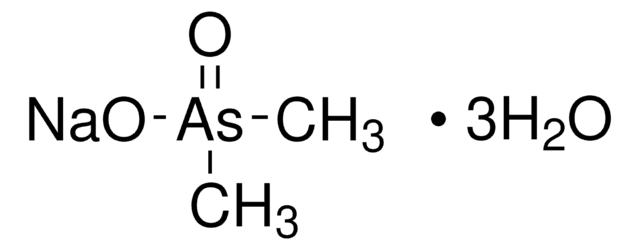G5882
Glutaraldehyde solution
Grade I, 25% in H2O, specially purified for use as an electron microscopy fixative
Synonym(s):
Glutaric dialdehyde solution, Pentane-1,5-dial
About This Item
Recommended Products
Quality Level
type
Grade I
form
liquid
concentration
25% in H2O
technique(s)
electron microscopy: suitable (fixative)
electron microscopy: suitable
color
colorless
useful pH range
2.9
mp
-10 °C ((14 °F ))
solubility
water: soluble at 20 °C
application(s)
cell analysis
shipped in
dry ice
storage temp.
−20°C
SMILES string
[H]C(CCCC([H])=O)=O
InChI
1S/C5H8O2/c6-4-2-1-3-5-7/h4-5H,1-3H2
InChI key
SXRSQZLOMIGNAQ-UHFFFAOYSA-N
Looking for similar products? Visit Product Comparison Guide
General description
Glutaraldehyde efficiently crosslinks amine and hydrazine derivatives to proteins and other amine-containing polymers. Notably, it has been used in certain reactions to directly couple biotin hydrazides to nucleic acids, suggesting potential applications in conjugating fluorescent hydrazides and hydroxylamines to DNA. In histology studies, Glutaraldehyde is employed to preserve tissue sections, preparing them for closer examination.
Application
- to fix the blood samples for scanning electron microscopy (SEM)
- to fix scaffold pieces for SEM analysis
- in drug treatments to treat K562 (leukemia) cells to permanently cross-link cell components
Biochem/physiol Actions
Features and Benefits
- Versatile and adaptable for wide variety of research applications
- Ready-made solution reduces the need for preparation time
Other Notes
Comparable product
signalword
Danger
Hazard Classifications
Acute Tox. 4 Inhalation - Acute Tox. 4 Oral - Aquatic Acute 1 - Aquatic Chronic 2 - Eye Dam. 1 - Resp. Sens. 1 - Skin Corr. 1B - Skin Sens. 1 - STOT SE 3
target_organs
Respiratory system
Storage Class
8A - Combustible corrosive hazardous materials
wgk_germany
WGK 3
ppe
Faceshields, Gloves, Goggles, type ABEK (EN14387) respirator filter
Choose from one of the most recent versions:
Already Own This Product?
Find documentation for the products that you have recently purchased in the Document Library.
Customers Also Viewed
Articles
This article discusses attachment-dependent cell growth and cell proliferation investigations using the MultiScreen Assay System from Millipore.
Related Content
Three-dimensional (3D) printing of biological tissue is rapidly becoming an integral part of tissue engineering.
Our team of scientists has experience in all areas of research including Life Science, Material Science, Chemical Synthesis, Chromatography, Analytical and many others.
Contact Technical Service





